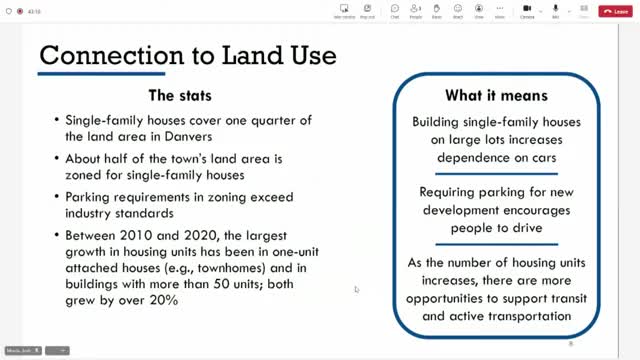Danvers evaluates housing and transportation links to reduce car dependency
March 26, 2025 | Town of Danvers, Essex County, Massachusetts
This article was created by AI summarizing key points discussed. AI makes mistakes, so for full details and context, please refer to the video of the full meeting. Please report any errors so we can fix them. Report an error »

In the heart of Danvers, Massachusetts, a recent Planning Board meeting illuminated the intricate relationship between land use, transportation, and community well-being. As town officials gathered under the bright lights of city hall, discussions unfolded around the pressing need to rethink how the town's layout impacts mobility and environmental sustainability.
One of the key topics was the prevalence of single-family housing in Danvers. With a significant portion of the town dedicated to larger lots, residents often find themselves reliant on cars for transportation. This sprawling layout not only diminishes walkability but also complicates efforts to promote biking and mixed-use developments. The board highlighted that high parking requirements in zoning laws further encourage driving, creating a cycle that perpetuates car dependency.
As the conversation progressed, the board noted a notable trend: an increase in multi-unit buildings with over 50 housing units. This shift presents an opportunity for Danvers to enhance public transit options and encourage active transportation, provided that new developments are strategically located.
The meeting also addressed the disconnect between where people live and work. Surprisingly, only 14% of Danvers residents are employed within the town, leading to increased traffic congestion as many commute elsewhere. The discussion touched on the evolving landscape of remote work, with some officials suggesting that the rise of hybrid work models could further alter commuting patterns.
Transportation's role in climate change was another focal point. The board referenced the Resilient Danvers plan, which underscores that transportation is a significant contributor to local emissions. Reducing these emissions is crucial for meeting the town's climate goals, and improving transportation options could yield substantial benefits.
The board also reviewed Danvers' participation in national programs like Complete Streets and Safe Routes to Schools. While the town has made strides in these areas, there remains room for improvement. Complete Streets aims to create roadways that accommodate various modes of transport, while Safe Routes to Schools focuses on ensuring safe pathways for students. However, the town has yet to fully leverage the funding opportunities available through these programs.
As the meeting drew to a close, the board acknowledged the importance of revisiting the Complete Streets prioritization plan to better align with current needs. With a commitment to enhancing transportation options and reducing emissions, Danvers is poised to take significant steps toward a more sustainable and connected future. The discussions from this meeting serve as a reminder of the ongoing challenges and opportunities that lie ahead for the town and its residents.
One of the key topics was the prevalence of single-family housing in Danvers. With a significant portion of the town dedicated to larger lots, residents often find themselves reliant on cars for transportation. This sprawling layout not only diminishes walkability but also complicates efforts to promote biking and mixed-use developments. The board highlighted that high parking requirements in zoning laws further encourage driving, creating a cycle that perpetuates car dependency.
As the conversation progressed, the board noted a notable trend: an increase in multi-unit buildings with over 50 housing units. This shift presents an opportunity for Danvers to enhance public transit options and encourage active transportation, provided that new developments are strategically located.
The meeting also addressed the disconnect between where people live and work. Surprisingly, only 14% of Danvers residents are employed within the town, leading to increased traffic congestion as many commute elsewhere. The discussion touched on the evolving landscape of remote work, with some officials suggesting that the rise of hybrid work models could further alter commuting patterns.
Transportation's role in climate change was another focal point. The board referenced the Resilient Danvers plan, which underscores that transportation is a significant contributor to local emissions. Reducing these emissions is crucial for meeting the town's climate goals, and improving transportation options could yield substantial benefits.
The board also reviewed Danvers' participation in national programs like Complete Streets and Safe Routes to Schools. While the town has made strides in these areas, there remains room for improvement. Complete Streets aims to create roadways that accommodate various modes of transport, while Safe Routes to Schools focuses on ensuring safe pathways for students. However, the town has yet to fully leverage the funding opportunities available through these programs.
As the meeting drew to a close, the board acknowledged the importance of revisiting the Complete Streets prioritization plan to better align with current needs. With a commitment to enhancing transportation options and reducing emissions, Danvers is poised to take significant steps toward a more sustainable and connected future. The discussions from this meeting serve as a reminder of the ongoing challenges and opportunities that lie ahead for the town and its residents.
View full meeting
This article is based on a recent meeting—watch the full video and explore the complete transcript for deeper insights into the discussion.
View full meeting
